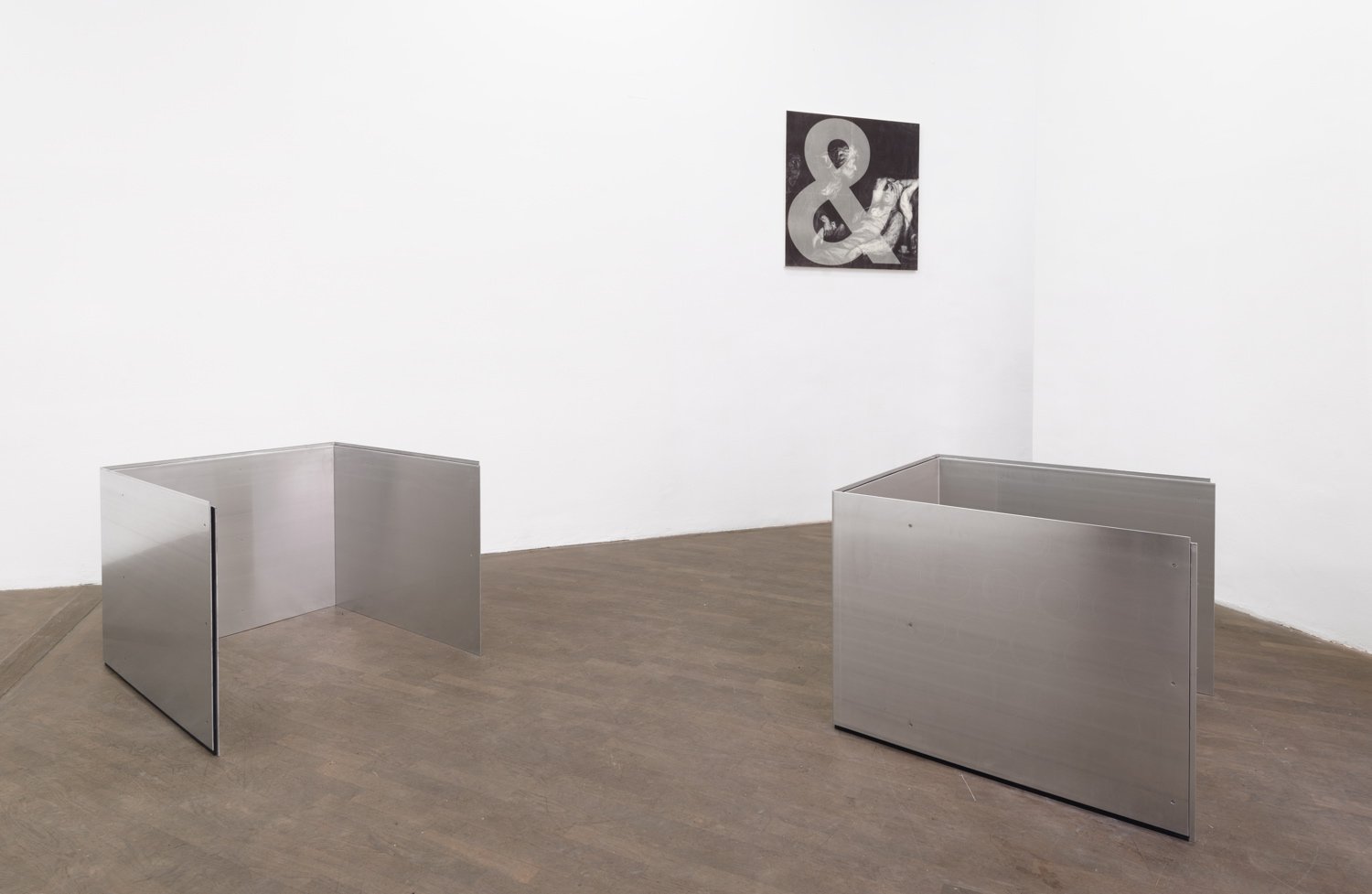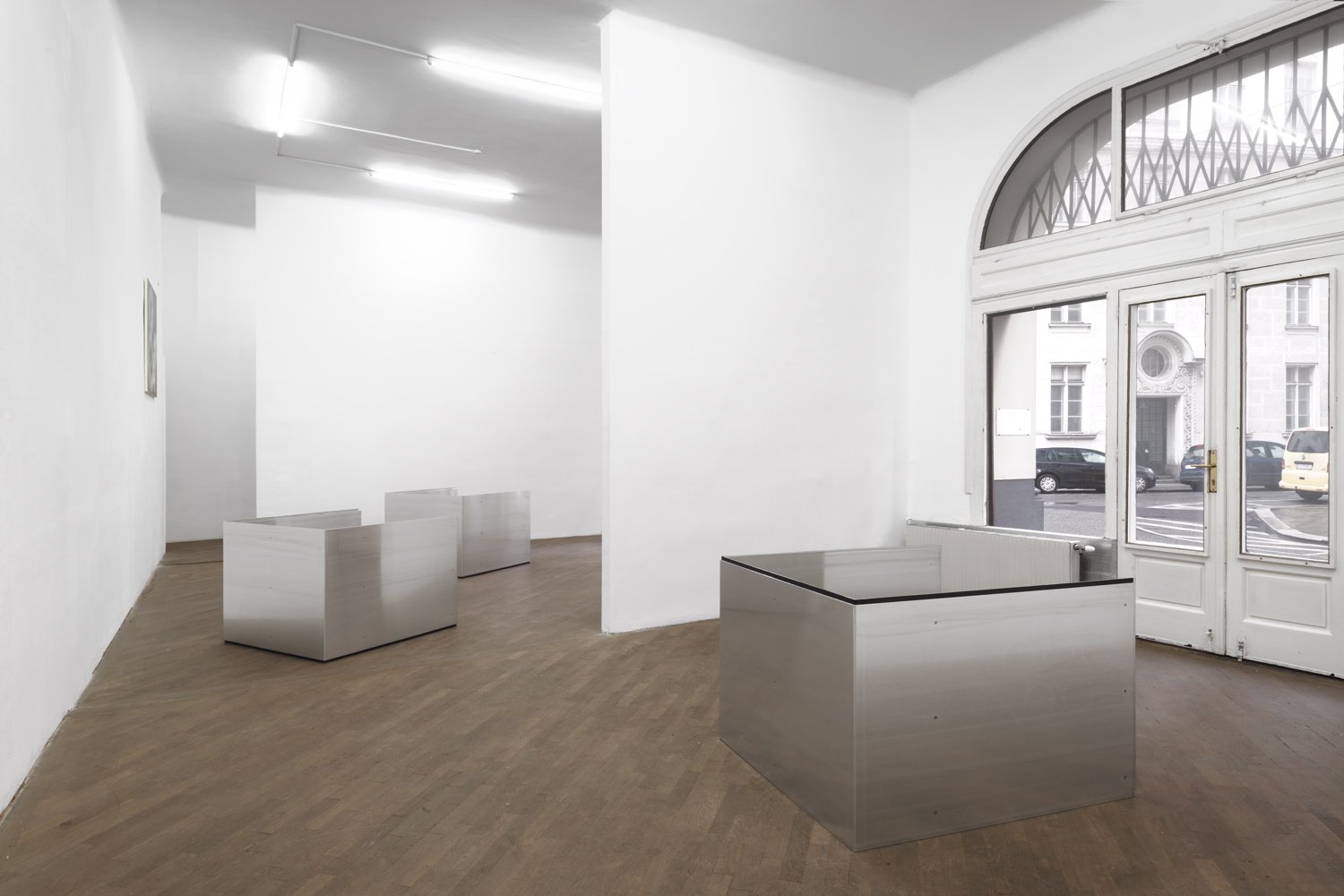An der Hülben
Benjamin Hirte
September 2 – 27, 2014

Benjamin Hirte, 2014
Installation view
Layr An der Hülben, Vienna

Benjamin Hirte
Chromes will break your heart, 2014
Chrome spray paint, cans, acrylic glass
48.5 × 13 × 8 cm

Benjamin Hirte
Untitled, 2014
Animated HD video

Benjamin Hirte, 2014
Installation view
Layr An der Hülben, Vienna

Benjamin Hirte
one.one, 2014
Aluminium, rubber and steel
77 × 100 × 100 cm

Benjamin Hirte, 2014
Installation view
Layr An der Hülben, Vienna

Benjamin Hirte
one.two, 2014
Aluminium, rubber and steel
77 × 100 × 100 cm

Benjamin Hirte
Os, 0s, 2014
UV direct print on polyamid pa 6.6
100 × 100 cm

Benjamin Hirte
Os, 0s, 2014
UV direct print on polyamid pa 6.6
100 × 100 cm

Benjamin Hirte, 2014
Installation view
Layr An der Hülben, Vienna

Benjamin Hirte, 2014
Installation view
Layr An der Hülben, Vienna

Benjamin Hirte, 2014
Installation view
Layr An der Hülben, Vienna
Aluminum is a soft, durable, lightweight, ductile and malleable metal with appearance ranging from silvery to dull gray, depending on the surface roughness. Owing to its resistance to corrosion, aluminium is one of the few metals that retain silvery reflectance in finely powdered form, making it an important component of silver-colored paints. Aluminium mirror finish has one of the highest reflectance of any metal.
Ampersand is a logogram “&” representing the conjunction word “and”. This symbol originated as a ligature of the letters et, Latinfor “and”. The word ampersand is a corruption of the phrase “and (&) per se and”, meaning “and (the symbol &) intrinsically is the word and”. Traditionally, when reciting the alphabet in English-speaking schools, any letter that could also be used as a word in itself (“A”, “I”, and, at one point, “O”) was preceded by the Latin expression per se (“by itself”). It was also common practice to add the “&” sign at the end of the alphabet as if it were the 27th letter, pronounced and. As a result, the recitation of the alphabet would end in “X, Y, Z, and per se and”. However, in contrast to the 26 letters, the ampersand does not represent a speech sound.
A can is acontainer for the distribution or storage of goods, composed of thin metal. Many cans require opening by cutting the “end” open; others have removable covers. Cans hold diverse contents: foods, beverages, oil, chemicals, etc. Use of aluminium in cans began in 1957. Aluminium is less costly than tin-plated steel but offers the same resistance to corrosion in addition to greater malleability, resulting in ease of manufacture; this gave rise to the two-piece can, where all but the top of the can is simply stamped out of a single piece of aluminium, rather than laboriously constructed from two pieces of steel. A can usually has a printed paper or plastic label glued to the outside of the curved surface, indicating its contents. Some labels contain additional information, such as recipes, on the reverse side. A label can also be printed directly onto the metal.
Chrome and silver paints are some of the most difficult paints to work with. Let me try to discourage you by saying you will only find varying levels of compromise, disappointment and heartache. Most “chrome” paints are far too delicate for high powered rocketry and should be avoided. It is my opinion that most metallic paints will oxidize and become dull. A clear coat will help seal the finish, but tends to make them look unnatural. Other chrome paints will be destroyed by a clear coat. It is very import to test the combination before hand. Grab an empty aluminum can and start testing.
A gasket is a mechanical seal which fills the space between two or more mating surfaces, generally to prevent leakage from or into the joined objects while under compression.
Honoré Daumier (1808-79) was a French printmaker, caricaturist, painter, and sculptor, whose many works offer commentary on social and political life in France in the 19th century.
A Module is a separable component, frequently one that is interchangeable with others, for assembly into units of differing size, complexity, or function.
O is the 15th letter and a vowel in the ISO basic Latin alphabet.
The letter O in isolation before a noun, usually capitalized, marks the vocative case as in the titles to O Canada or O Captain! My Captain! or certain Bible verses.
o.o
Depending on if there are caps, or where they are/how arranged:
o.o : blank stare, as in “You’ve just lost me” Or “I care about this…Why, again?”
O.o ; o.O : Confusion, usually used together.
O.O : Suprise, shock.
Polyamid 6.6, PA 6.6 also referred to as Nylon 6.6, is a polyamide from nylon class. Polyamid is frequently used when high mechanical strength, great rigidity, and good stability under heat is required. It is used for ball bearing cages, electro-insulating elements, pipes, profiles and various machine parts. Other popular applications are: carpet fibres, apparel, airbags, tyres, zip ties, ropes, conveyor belts, hoses and the outer layer of turnout blankets.
Rubber is a latex material, originally from the Para rubber tree. Around 25 million tonnes of rubber is produced each year, of which 42 percent is natural rubber. The remainder is synthetic rubber derived from petrochemical sources. The mid-range which comes from the technically-specified natural rubber materials ends up largely in tires but also in conveyor belts, marine products, windshield wipers and miscellaneous rubber goods. Natural rubber offers good elasticity, while synthetic materials tend to offer better resistance to environmental factors such as oils, temperature, chemicals or ultraviolet light and suchlike.
A rope is a group of plies, yarns or strands which are twisted or braided together in order to combine them into a larger and stronger form. Ropes have tensile strength and so can be used for dragging and lifting, but are too flexible to provide compressive strength. As a result, they cannot be used for pushing or similar compressive applications. Rope is thicker and stronger than similarly constructed cord, line, string, and twine. Ropes made from metal strands are called wire rope.
A tag is
– a piece or strip of strong paper, plastic, metal, leather, etc., for attaching by one end to something as a mark or label: The price is on the tag.
– any small hanging or loosely attached part or piece; tatter.
– symbol, mark, or other labeling deviceindicating the beginning or end of a unit of information.
– a label taking the form of a keyword or short phrase, used to classify or organize digital data,aid online searches, etc.
– Slang: a person’s name, nickname, initials, monogram, or symbol.
The Imaginary Invalid (French: Le malade imaginaire) is a three-act comédie-ballet by the French playwright Molière with dance sequences and musical interludes by Marc-Antoine Charpentier. It premiered on 10 February 1673 at the Théâtre du Palais-Royal in Parisa. Le malade imaginaire would turn out to be Molière’s last work. He collapsed during his fourth performance and died soon after. An important theme in “The imaginary Invalid” is the “play with death” in many variations.
0 (zero) is both a number and the numerical digit used to represent that number innumerals. It fulfills a central role in mathematics as the additive identity of the integers, real numbers, and many otheralgebraic structures. As a digit, 0 is used as a placeholder in place value systems. In the English language, 0 may be called zero, nought or (US) naught, nil, or — in contexts where at least one adjacent digit distinguishes it from the letter “O” — oh or o.